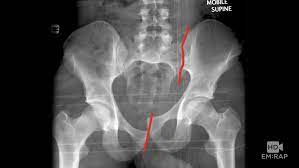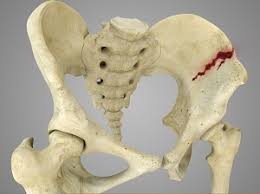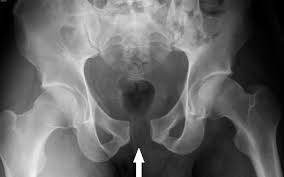

 Mortality of patients who suffer pelvic fractures ranges from 5% to 10%, with an overall lower mortality of 5% if simple fractures are included.
Mortality of patients who suffer pelvic fractures ranges from 5% to 10%, with an overall lower mortality of 5% if simple fractures are included.
Routine pelvic radiograph for blunt trauma patients is used by most trauma centers as an early identification of a pelvic fracture that may be a potential source of hemorrhage and increased mortality.
A pelvic fracture is a break of the bony structure of the pelvis: any break of the sacrum, hip bones (ischium, pubis, ilium), or tailbone.
Symptoms include pain, particularly with movement.
Complications may include internal bleeding, injury to the bladder, or vaginal trauma.
Common causes of pelvic fracture includes: falls, motor vehicle collisions, a vehicle hitting a pedestrian, or a direct crush injury.
In younger people more significant trauma is typically required, while in older individuals less significant trauma can result in a fracture.
Pelvic fractures are divided into two types: stable and unstable.
Unstable pelvic fractures can be further divided into anterior/posterior, compression, lateral compression, vertical shear, and combined mechanism fractures.
Diagnosis is suspected on the basis of history, symptoms and examination with confirmation by X-rays or CT scan.
A pelvic fracture with no pain requires no medical imaging.
Emergency treatment begins with efforts to stop bleeding and replace fluids.
Bleeding control may be achieved by using a pelvic binder to support the pelvis, angiographic embolization or preperitoneal packing.
The pelvis may require surgical reconstruction.
Pelvic fractures account for around 3% of adult fractures.
Stable fractures generally have a good prognosis.
The risk of death with an unstable fracture is about 15%.
In patients with unstable pelvic fracture and blood pressure have a risk of death approaching 50%.
Unstable fractures are often associated with injuries to other parts of the body.
Complications can result in cases of excess blood loss or puncture to certain organs, possibly leading to shock.
The bony pelvis consists of the ilium, ischium, and pubis, which form an anatomic ring with the sacrum.
Disruption of this ring requires significant energy.
The bony pelvis consists of the ilium, ischium, and pubis, which form an anatomic ring with the sacrum.
Disruption of this ring requires significant energy.
The pubic bone, the ischium and the ilium make up the pelvic girdle, fused together as one unit.
They attach to both sides of the spine and circle around to create a ring and sockets to place hip joints.
This attachment to the spine directs force into the trunk from the legs as movement occurs, extending to one’s back.
The pelvis must be strong enough to withstand pressure and energy.
Muscles play important roles in pelvic stability.
Pelvic fractures frequently involve injury to organs contained within the bony pelvis, but trauma to extra-pelvic organs is common.
Pelvic fractures are often associated with severe hemorrhage, related to due to the extensive blood supply to the region.
The veins of the presacral pelvic plexus are particularly vulnerable to pelvic traumatic fracture.
Greater than 85 percent of bleeding due to pelvic fractures is venous or from the open surfaces of the bone.
Pelvic fractures are most commonly described using one of two classification systems.
The Tile classification system is based on the integrity of the posterior sacroiliac complex.
In type A injuries, the sacroiliac complex is intact, and pelvic ring has a stable fracture that can be managed nonoperatively.
Type B injuries are caused by either external or internal rotational forces resulting in partial disruption of the posterior sacroiliac complex.
Type B fractures are often unstable.
With Type C injuries there is complete disruption of the posterior sacroiliac complex and are both rotationally and vertically unstable.
Type C injuries are the result of great force, usually from a motor vehicle crash, or fall from a height or severe compression.
The Young and Burgess classification is a modification of the Tile classification.
It is the recommended and most widely used classification system for pelvic ring fractures, taking into account force type, severity, and direction, as well as injury instability.
Anteroposterior compression (APC)
APC I: stable with pubic diastasis <2.5 cm
APC II: rotationally unstable, vertically stable with pubic diastasis >2.5 cm.
disruption and diastasis of the anterior part of the sacroiliac joint, with intact posterior sacroiliac joint ligaments.
APC III: equates to a complete hemipelvis separation; unstable
pubic diastasis >2.5 cm
disruption-diastasis of both anterior and posterior sacroiliac joint ligaments with dislocation
Lateral compression
LC I: stable
oblique fracture of pubic rami
ipsilateral anterior compression fracture of the sacral ala
LC II: rotationally unstable, vertically stable
fracture of pubic rami
posterior fracture with dislocation of the ipsilateral iliac wing
LC III: unstable
ipsilateral lateral compression (LC)
contralateral anteroposterior compression (APC)
Vertical shear (VS)
Most severe and unstable type with a high association of visceral injuries.
vertical displacement of hemipelvis, pubic and sacroiliac joint fractures
Stability depends on the individual components of a combined injury.
complex fracture, including a combination of anteroposterior compression (APC), lateral compression (LC), and/or vertical shear (VS)
Superior view, Pelvic Fracture Types (2006). Force and break are shown by matching color: Anteroposterior compression type I (orange), Anteroposterior compression type II (green), Anteroposterior compression type III (blue); Lateral compression type I (red), Lateral compression type II (purple), F. Lateral compression type III (black). Increased force and breaks are shown by increasing size.This fracture is best viewed anteriorly, while the other fractures are viewed superiorly. The arrow indicates where the force is coming from, and the colored lines indicate where the break occurs.
The Young-Burgess classification system is based on mechanism of injury: anteroposterior compression type I, II and III, lateral compression types I, II and III, and vertical shear, or a combination of forces.
Lateral compression (LC) fractures involve transverse fractures of the pubic rami, either ipsilateral or contralateral to a posterior injury.
Grade I – Associated sacral compression on side of impact
Grade II – Associated posterior iliac fracture on side of impact
Grade III – Associated contralateral sacroiliac joint injury
The most common force type injury from lateral compression (LC) forces, come from side-impact automobile accidents and pedestrian injuries, resulting in internal rotation.
The superior and inferior pubic rami may fracture anteriorly.
Injuries from shear forces, like falls from above, can result in disruption of ligaments or bones.
An open book fracture is often the result of a heavy impact to the groin : motorcycling accident injury, resulting in the left and right halves of the pelvis are separated at front and rear, with front opening more than the rear, i.e. like an open book that falls to the ground and splits in the middle.
An open book fracture may require surgical reconstruction.
Forces from an anterior or posterior direction, like head-on car accidents, can cause external rotation of the hemipelvis, resulting on an open-book injury.
Open fractures of the pelvic have an increased risk of infection and hemorrhage with a higher mortality.
Precautions are crucial in order to lower the risk of getting pelvic fractures.
Avoiding car accidents, cycling accidents prevents high energy injury.
Falling is one of the mot common causes of pelvic fracture.
Treatment
The pelvis ring should be stabilized with a pelvic binder, that reduces blood loss from the pelvic vessels and reduced the risk of death.
Many surgical methods of pelvic stabilization are used including external fixation or internal fixation and traction.
Pelvic fractures that are treatable without surgery are treated with bed rest, followed by a rehabilitation program.
The mortality rates in people with pelvic fractures are between 10 and 16 percent.
Death is typically due to associated trauma affecting other organs, such as the brain, and death rates due to complications directly related to pelvic fractures, such as bleeding, are relatively low.
About 10 percent of people that seek treatment at a level 1 trauma center after a blunt force injury have a pelvic fracture.
Motorcycle injuries are the most common cause of pelvic fractures, followed by injuries to pedestrians caused by motor vehicles, far falls over 15 feet, and motor vehicle crashes.
